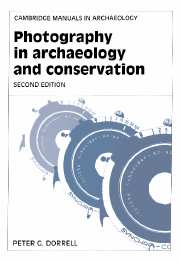Book contents
- Frontmatter
- Contents
- List of illustrations
- Preface
- Preface to the second edition
- Acknowledgements
- 1 The early days of archaeological photography
- 2 Basic principles and practice
- 3 Equipment
- 4 Lighting by flash
- 5 Photographic materials, processing and printing
- 6 Architecture and standing monuments
- 7 Survey photography
- 8 Site photography
- 9 Principles of object photography
- 10 Principles of close-up photography
- 11 Ultra-violet and infra-red photography
- 12 Photographing finds
- 13 Flat copy
- 14 Preparation of material for publication
- 15 The future
- References
- Index
8 - Site photography
Published online by Cambridge University Press: 23 December 2009
- Frontmatter
- Contents
- List of illustrations
- Preface
- Preface to the second edition
- Acknowledgements
- 1 The early days of archaeological photography
- 2 Basic principles and practice
- 3 Equipment
- 4 Lighting by flash
- 5 Photographic materials, processing and printing
- 6 Architecture and standing monuments
- 7 Survey photography
- 8 Site photography
- 9 Principles of object photography
- 10 Principles of close-up photography
- 11 Ultra-violet and infra-red photography
- 12 Photographing finds
- 13 Flat copy
- 14 Preparation of material for publication
- 15 The future
- References
- Index
Summary
During the course of an excavation, photographs are taken for a number of purposes. Most important of these must, of course, be to preserve a record of the site and to provide illustrations for the published report, showing the appearance and relationship of walls, floors and buildings, and the details of constructions and of in situ artifacts. Ideally, photographs, plans and sections should complement each other, so that the position and measurements of each structure can be immediately matched to its visual appearance. Moreover, viewpoints should be chosen and the features excavated and cleaned in such a way that all the evidence on which are based theories of construction and chronology is revealed. This is a counsel of perfection, and such a display of archeological logic will probably never be achieved; but at least a serious attempt should be made to avoid the situation, all too common, where vital evidence has not been recorded and where, following the destruction of successive strata, assumptions and theories must go unsupported.
Two other aspects of site photography, of almost equal importance, should not be overlooked. Firstly, the dig must be placed in the landscape. Unless by good fortune a member of the dig staff has the rare talent of accurate landscape drawing, the photographer must be responsible for the recording of such things as the siting and aspect of the settlement in relation to communications, water, arable land, other sites, local topography, geology, flora and so on.
- Type
- Chapter
- Information
- Photography in Archaeology and Conservation , pp. 120 - 153Publisher: Cambridge University PressPrint publication year: 1994



